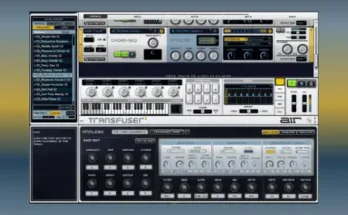Ochen K Probability CV Trigger v1.1.2
DECiBEL | 26 Mar 2022 | 42 MB
The PCV is a probability CV step sequencer trigger that allows you to generate sequences of three different types of CV signals within custom ranges according to random probabilities. Create sequences up to 32 steps long with step resolutions anywhere between a half-note and a thirty-second note in length.
The PCV is a utility to generate CV signals that aren’t based on LFOs or other analog concepts of looping oscillation. With the PCV, you can create sequences that include randomized values within ranges that you control.
Three CV data types are generated by the PCV – Unipolar, Bipolar, and Note CV data. Unipolar CV signals range from zero to 100 percent. Bipolar CV signals range from -100 percent to 100 percent. And Note CV signals range from 1 to 127. Many faders and dials that go from zero to some value, like filter frequencies, ADSR values, and LFO rates are usually Unipolar. Dials and wheels where the neutral value is in the middle, like pitch bend wheels and pan knobs are Bipolar. And elements that control note values, like instrument sequencer CV ins are Note CVs.
The PCV’s sequencer has three dials per step. The top dial is a probability dial. This determines the likelihood of a CV value being triggered at that step. When the probability is at 100 percent, a CV value will be generated every time the PCV sequencer gets to that step. When the probability is at zero, no CV value will ever be triggered when the PCV sequencer gets to that step. But when the probability is between zero and 100 percent, the percentage determines the likelihood of a CV value being triggered at that step. For example, if the probability dial of step 1 is at 60 percent, every time the PCV sequencer gets to step 1, there is a 60 percent chance that the PCV will trigger a new CV value.
The middle dial at each step is the minimum value of the range of possible generated CV values. The bottom dial is the maximum value of the range of possible generated CV values. So, if the PCV sequencer determines that a value should be triggered at step 1, the value generated will be somewhere between the minimum and maximum values for that step. When the minimum and maximum value are the same, a CV signal at that value will be triggered.
The Portamento dial determines how quickly the CV signal changes between steps. When Port is at zero, the change in CV values happens immediately. When Port is at 100 percent, the value slowly changes over the duration of an entire step.
The Steps dial determines the length, in steps, of your sequencer. Sequences can be any length between 1 and 32 steps. Steps beyond the 16th step reuse the dial values of the first 16 steps.
The Speed dial sets the resolution of each step of the sequence. Each step can last anywhere between a half note and a thirty-second note.
The Gate dial determines the duration of each trigger, ranging from nearly no duration, to a duration four times the length of the step resolution. So, if each step lasts 1/4 note, a gate of 100% lasts a whole note.
The PCV has an automatable Pause button to stop the sequencer, a local Shuffle dial, and a Seed dial to change the seed of the random number generator inside the PCV.
On the back of the PCV, the PCV’s CV signals come out of the CV out jack, and the Seed dial value can be controlled by a CV in signal.
The PCV provides a way to generate unique sequences of CV values that are as exact or as surprising as you want them to be.
Please REPORT in Comment Broken Links




